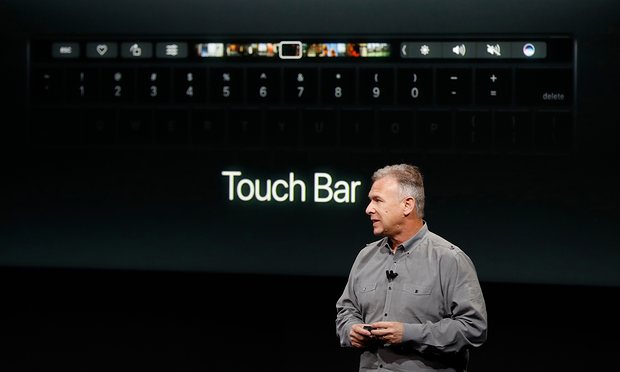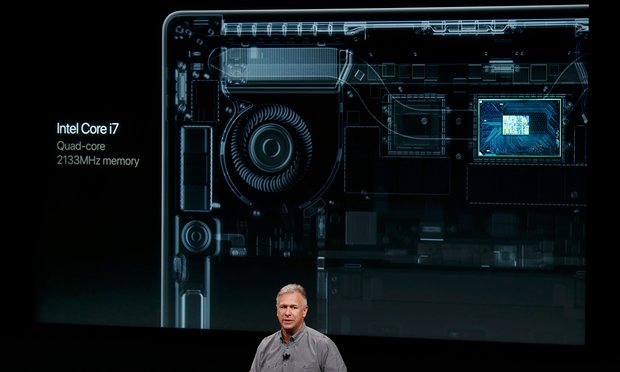Apple launches new MacBook Pro laptop with instant emoji Touch Bar
Apple has launched the first new version of its MacBook Pro laptop in 18 months, with a new OLED touchscreen on the keyboard capable of inserting emoji into text, as well as updates to the rest of its laptop line.
It has two USB-C Thunderbolt 3 ports along each side – four in total – that are used for both power and connectivity. However, there are no standard USB type A ports, which are still regarded as the global standard, and are used by Apple for their Lightning cable , which comes with the company’s iPhones.
The new laptop does not come with the SD card reader, HDMI port, the two Thunderbolt ports that doubled as a mini DisplayPorts, or the two USB-A ports that the last model did, so will require adapters to use existing accessories. It also lacks the MagSafe power adapter, instead relying on USB-C. It does have a 3.5mm headphone socket, however.
 |
| The Touch Bar is a customisable and context-sensitive OLED touchscreen positioned above the keyboard. Photograph: Stephen Lam/Getty Images |
The biggest change to the design of the machine is a new OLED touch panel above the standard keyboard, which replaces the multi-function “F” keys, and allows dynamic shortcuts to functions such as volume control and window management.
Craig Federighi, senior vice president of software engineering for Apple, showed that the Touch Bar could be used for navigation in browsers, photo manipulation and text suggestions when typing. It can also suggest and insert emojis without leaving the keyboard.
The right end of the strip now contains Apple’s Touch ID fingerprint scanner integrated into the power button, which is similar to the one fitted to the iPhone and iPad and can be used to unlock the laptop and confirm payments. The new Force Touch trackpad is also twice the size of the old one.
Apple said the new 13in MacBook Pro can be equipped with dual-core versions of the Intel i5 or i7 processor, 8GB of RAM, 256GB storage and Intel’s Iris 550 integrated graphics chip with 103% faster gaming performance and 76% faster video editing and 3D graphics performance than the previous version.
But the new 15in MacBook Pro is by far the more powerful, with a quad-core version of Intel’s i7 processor, 16GB of RAM and 256GB of storage. It also comes with an AMD Radeon Pro 450 graphics chip that offers up to 4GB of video RAM, with 130% faster 3D graphics, 60% faster gaming and 57% faster video editing.
Both models have up to 10 hours of battery life, Apple said.
 |
| Schiller speaks under a graphic of the processor of a new 15in MacBook Pro during an Apple media event in Cupertino. Photograph: Beck Diefenbach/Reuters |
The new MacBook Pro will be for sale immediately, shipping in two to three weeks, with the 13in version costing $1,799 in the US and £1,749 in the UK and the 15in costing $2,399 in the UK and £2,349 in the UK. Apple is also making a lower specification 13in version without the Touch Bar, Touch ID and only two Thunderbolt ports costing $1,499 in the US and £1,449 in the UK, which will ship immediately.
The updates come at a time when Apple’s Mac shipments have seen three straight quarters of decline, culminating in a greater than 14% drop year-on-year in the last quarter. The decline follows Apple’s total sales of Macs growing by almost 6% in 2015, to which the launch of the new retina MacBook contributed.
At the same time, total PC shipments shrank by 8% globally year-on-year in 2015 and 0.2% year-on-year in 2014, according to data from Gartner. Even Lenovo, the world’s largest PC manufacturer, has shown decreasing sales, down 3.1% in 2015 and down three straight quarters in 2016.
Revenues from Apple’s Mac computers are now worth less than those of its services, such as the App Store and iTunes. The company will be hoping that the renewed laptops and computer will buoy sales and return the Mac line to second place behind the iPhone in total revenue contribution to Apple’s bottom line.

